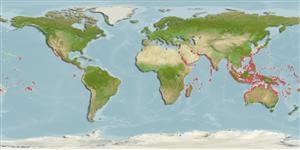Malacostraca |
Decapoda |
Portunidae
Environment: milieu / climate zone / depth range / distribution range
Ecology
Benthic; brackish; depth range 0 - 10 m (Ref. 96667). Tropical
Indo-Pacific.
Length at first maturity / Size / Weight / Age
Maturity: Lm ? range ? - ? cm Max length : 8.0 cm CW male/unsexed; (Ref. )
Surface of carapace smooth, ridges low but distinct; front with 6 equal-sized, rounded lobes. Color: dark to olive green overall.
Also caught by nets (Ref. 343). This species possess toxins but in low toxicities, and are therefore considered as a toxin-free crab (Ref. 130560). Found along the neritic zone (Ref. 97241). Inhabits shallow non-reef habitat with soft substrates (Ref. 106854), and intertidal mudflats (Ref. 128960). Estuarine (Ref. 106854). Prefers areas near mangroves, on mangrove swamps per se (Ref. 8752) or with muddy-rocky substrates (Ref. 343) in intertidal platforms (Ref. 8752). Also found in reef areas. A free-living predatory carnivore (Refs. 97241, 128960). Feeds mainly on slow-moving invertebrates colonizing mangrove swamps; also a scavenger (Ref. 8752).
Life cycle and mating behavior
Maturity | Reproduction | Spawning | Eggs | Fecundity | Larvae
Members of the order Decapoda are mostly gonochoric. Mating behavior: Precopulatory courtship ritual is common (through olfactory and tactile cues); usually indirect sperm transfer.
Ng, P.K.L. 1998 Crabs. p. 1045-1155. In K.E. Carpenter and V.H. Niem (eds) FAO species identification guide for fishery purposes. The living marine resources of the Western Central Pacific. Volume 2. Cephalopods, crustaceans, holothurians and sharks. Rome, FAO. 1998. pp. 687-1396. (Ref. 343)
IUCN Red List Status
(Ref. 130435: Version 2025-1)
CITES status (Ref. 108899)
Not Evaluated
Not Evaluated
Threat to humans
Human uses
Fisheries: commercial
| FishSource | Sea Around Us
Tools
More information
Life cycleReproductionMaturityFecunditySpawningEggsEgg developmentLarvae PhysiologyOxygen consumption
Human RelatedStamps, coins, misc.
Internet sources
Estimates based on models
Preferred temperature
(Ref.
115969): 24.3 - 29.3, mean 28.3 (based on 3830 cells).
Resilience
High, minimum population doubling time less than 15 months (K=1.7).
Fishing Vulnerability
Low vulnerability (10 of 100).
Price category
Unknown.
Nutrients : Calcium = 109 [35, 184] mg/100g; Iron = 1.59 [1.21, 1.97] mg/100g; Protein = 20.2 [19.2, 21.3] %; Omega3 = 0.285 [0.185, 0.386] g/100g; Selenium = 48.3 [-31.7, 128.3] μg/100g; VitaminA = 0 μg/100g; Zinc = 1.79 [1.17, 2.40] mg/100g (wet weight); based on
nutrient studies.
